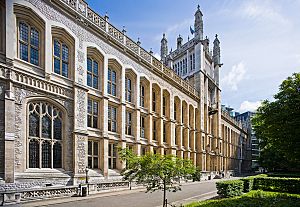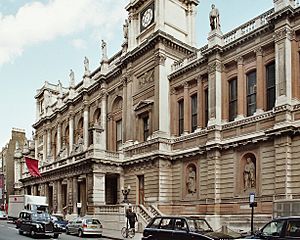James Pennethorne facts for kids
Sir James Pennethorne (born June 4, 1801 – died September 1, 1871) was an important English architect and city planner. He lived in the 1800s and is famous for designing many buildings and parks in the heart of London.
Contents
Life of a Master Builder
Starting His Career
James Pennethorne was born in Worcester. In 1820, he moved to London to learn about architecture. He studied with famous architects like Augustus Charles Pugin and John Nash. John Nash was a relative of James's family.
In 1824, James traveled to France, Italy, and Sicily. He studied old buildings in Rome and even designed a plan to fix the ancient Forum. This plan helped him become a member of a special art academy called St. Luke.
When he returned to London in 1826, he worked for John Nash. He helped Nash with big projects like improving West Strand and King William Street. After Nash passed away, James finished the Park Village East and West areas in Regent's Park.
Until 1840, James also worked on his own projects. He designed buildings like the Bazaar in St. James's Street and Swithland Hall in Leicestershire. During this time, he also started working for the government. This government work would soon become his main focus.
In 1832, the government hired him to plan new improvements for London. He wanted to build a huge street across the city, but it was too big a project. However, four streets were built based on his ideas: New Oxford Street, Endell Street, Cranbourn Street, and Commercial Street. Later, in 1855, the Metropolitan Board of Works used more of his old designs to build streets like Garrick Street and Southwark Street.
Working for the Government
After 1840, James Pennethorne worked only for the government. He became the main architect for the Office of Woods in 1843. He also helped look into how workhouses were built in Ireland.
One of his important designs was the Museum of Practical Geology. This museum, built between 1847 and 1849, also held offices for the Geological Survey. It opened in 1851.
In 1847, he drew plans for the Public Record Office in Fetter Lane. Parts of his design were built starting in 1850. He also made changes to Nash's Quadrant in Regent Street in 1848.
James worked on Buckingham Palace in 1852, adding a ballroom and supper-room. He also built other government buildings near the palace. Between 1852 and 1856, he finished the west side of Somerset House.
He was also in charge of creating two large parks: Victoria Park in Tower Hamlets and Battersea Park. He also planned a park called "Albert Park" in Islington, but it was never built.
In 1853, he made plans for the area around the 1851 Exhibition in South Kensington. He even suggested moving the National Gallery there. Later, he designed a building to connect new museum buildings with existing art schools.
James was asked to design a memorial for Prince Albert in 1862. He suggested a classical building, but a Gothic design was chosen instead. He also drew plans for new government offices in Downing Street and a War Office in Pall Mall, but these were not built.
His last major project was for the University of London at 6 Burlington Gardens. He had advised the government to buy the nearby Burlington House. This building would house important societies and the Royal Academy. His plans for the University of London were approved in 1866.
In November 1870, James Pennethorne was given the title of Knight. This was to honor his many years of public service. His brother, John Pennethorne, was also an architect.
Important Buildings and Parks
Private Projects
- East and West Park Villages, Regent's Park (finished after John Nash's death)
- Christ Church, Albany Street (1836)
- The Bazaar, St. James's Street
- Swithland Hall, Leicestershire
- Dillington House, Ilminster
Public Buildings
- Museum of Practical Geology, Jermyn Street (1847–49)
- Public Record Office, Chancery Lane, London (1851–1858 – now the Maughan Library of King's College London)

- Ballroom at Buckingham Palace, London (1854)
- West wing of Somerset House, London (1849–1856)
- Changes to the National Gallery, London (1860–1869)
- Army Staff College, at Royal Military College, Sandhurst (1862)
- Changes to Marlborough House, London (now home to the Commonwealth Secretariat) (1863)
- 6 Burlington Gardens, London (originally for the University of London, now part of the Royal Academy) (1867–1870)
Parks He Designed
- Kennington Park, south London
- Victoria Park, East London (started in 1842, opened 1846)
- Battersea Park, south London (1846 to 1864, designed with John Gibson)
Images for kids



